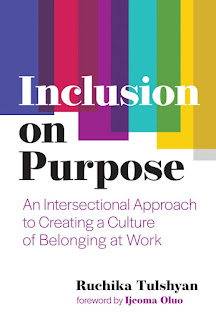“Inclusion takes awareness, intention, and regular practice,” explains Tulshyan. “Women of color representation is rapidly growing in Western workplaces and will be the majority of working women in the United States by 2050 accordingly to Catalyst (February 1, 2021).”
“I use ‘women of color’ broadly, acknowledging that it is a flawed an incomplete term. I am referring to Black, Asian, Latinx, or Native or Indigenous women,” she adds.
In her book, Tulshyan includes an entire chapter on the topic of how to develop empathy as an inclusive leader – including definitions and explanations of:
- Affective empathy (how easily can you feel another person’s emotions).
- Cognitive empathy (can you understand and empathize with perspectives that may not be like yours).
- Empathic Concern (how easily do you get concerned about another person’s challenges) .
“Inclusive leaders must cultivate cognitive empathy, which demands that we don’t automatically assume that others experience the workplace in the same way we do. Instead. They believe that there is nuance to how peers are experiencing the workplace—especially based on their identity and how they are perceived, frequently dependent on the stereotypes associated with those identities,” shares Tulshyan.
Another critical chapter in the book is the one devoted to a leader’s role in creating inclusive hiring practices. This chapter includes helpful guidelines for interviewing and how to reduce bias while interviewing.
Today, Tulshyan shares these additional insights with us:
Question: You write about the gap between intention and action when it comes to inclusion. Why do you think this still exists, and how can we be better about addressing it?
Tulshyan: Research shows that many of us haven't grown up with diversity in our lives and the first time many Americans meaningfully interact with a person from a different racial background is in the workplace. We need to see this as an opportunity to grow, not retreat into creating more homogenous teams because that’s what we’re familiar with.
Question: How can leaders develop an inclusion mindset and what actions can they take to elevate women of color in the workplace?
Tulshyan: An inclusion mindset draws from the seminal work of Dr. Carol Dweck, that with a growth mindset, we can all learn and grow. Applying that growth mindset to inclusion, we must know that even if we were taught that practicing inclusion and reducing bias wasn’t that important, we must and can grow to make change. When we have an inclusion mindset, we know that we will make mistakes and we don’t know everything there is to know about DE&I but we do not let that limit us in our quest to be more inclusive leaders.
There are a number of actions that leaders can take to elevate women of color, but the most important is to spend time learning where women of color experience challenges in the workplace; that spans from experiencing hiring biases to barriers to equal pay, promotion and progress to leadership opportunities. Once you identify and understand how and why these barriers exist, that’s when you can take action. Without this awareness first, the actions won’t be meaningful or sustainable.
Question: What other books would you recommend reading to further develop an inclusion mindset?
Tulshyan: In my book, I recommend, So You Want To Talk About Race, by Ijeoma Oluo; Caste: The Origins of Our Discontents, by Isabel Wilkerson and, How To Be An Antiracist, by Ibram X. Kendi as required reading in tandem with my book, to better understand the history of anti-Black racism in America. Depending on where you are in the world, I recommend seeking local/regional versions that contextualize inequity and justice in that region.
Building empathy is a key part of developing
an inclusion mindset. So, I recommend reading fiction by authors from
underrepresented and underestimated communities, writing about experiences we
don’t see covered in the mainstream enough, to help leaders cultivate empathy.
Some recent favorites include, Homegoing, by Yaa Gyasi, Convenience Store
Woman, by Sayaka Murata and Ginny Tapley Takemori (translator), Mexican Gothic,
by Silvia Moreno-Garcia and, Border Less, by Namrata Poddar.
Question: What are the couple takeaways from your book for how a leader can take action tomorrow to be a more inclusive leader and to develop empathy?
Tulshyan: Audit your social and professional network; do the people closest to you share the same identities as you; race, gender, education, socioeconomic status etc? If yes, how can you meaningfully diversify and expand your network?
Audit what type of media
and literature you typically consume. Is it mostly by and for people
who are in the dominant-group majority in your society? How can you meaningfully
diversify and expand to include community media and media and literature that
centers underrepresented voices?
Take time and care to pronounce names correctly, take note of your employees’ pronouns and other seemingly small details that would meaningfully impact how valued and welcome another would feel.
Hire for “culture add,” not “culture fit.” When we default to hiring for culture fit, we usually hire for sameness of who is already represented, especially by race and gender. Seek to understand which perspectives are missing today and how you can include them to expand and add to your organization or team’s culture.
Practice active listening. Listen to hear, not to respond. This means that if someone offers you feedback (in a constructive manner, of course) that makes you feel uncomfortable or defensive, actively push through the discomfort and sit with it. Focus less on the intention you had and make space for the impact it had.
Thank you to the book’s publisher
for sending me an advance copy of the book.

.jpg)
Comments
Post a Comment